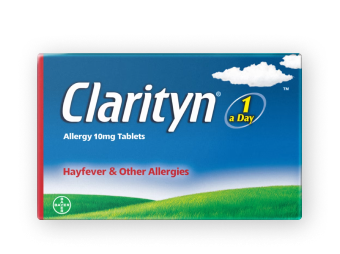What is the Clarityn Pollen Forecast?
Our pollen tracker forecasts the pollen levels in your area so you can be prepared for the day. Going on a trip? Just enter the postcode or location to see the pollen count for that area, so you know what precautions you may need to take.
Our pollen tracker even breaks down the pollen count so you can see what sort of pollen is at its peak today – tree, grass or weed. For more information on the kinds of pollen and where they come from, check out our hayfever blog!
What is the pollen count?
The pollen count is the amount of pollen per cubic meter observed in 24 hours. This is called the PPM number (Pollen Grains Per Cubic Meter).
DID YOU KNOW?
The pollen forecast is literally a pollen count! Pollen is physically collected in a Burkard trap, which contains sticky paper. The trap rotates, and as air flows through it pollen particles get stuck to the paper and are counted under a microscope… by hand!
What counts as a “high” pollen count?
The rating given to the pollen count depends on the kind of pollen being counted. There are three main kinds of pollen: tree, weed and grass. The below table looks at the three kinds of pollen, and what the PPM (Pollen grains per cubic meter) needs to be to trigger each pollen count level.
Grass | Trees | Weeds | |
|---|---|---|---|
| Low | 1 – 4 PPM | 1 – 14 PPM | 1 – 9 PPM |
| Moderate | 5 – 19 PPM | 15 – 89 PPM | 10 – 49 PPM |
| High | 20 – 199 PPM | 90 – 1499 PPM | 50 – 499 PPM |
| Very high | 200+ PPM | 1500+ PPM | 500+ PPM |
Typically, you may start to have hayfever symptoms when the pollen count gets to 50 and above, although everyone responds to pollen differently!
How does the Clarityn Pollen Tracker work?
Our reliable pollen tracker is powered by data from Ambee, which takes its data from two points:
- Pollen traps
- The types of pollen-producers in your area (like trees, grass and leaves)
What makes allergies worse?
Seasons and allergies
Allergies vary from season to season as different pollens peak at different times. When each kind of pollen is released can vary on weather and what part of the country you’re in.
- SPRING (MARCH – MAY) – Tree pollen peaks in spring. Grass pollen begins to release.
- SUMMER (JUNE – AUGUST) – Grass pollen is released until around July. Weed pollen begins to start around June.
- AUTUMN (SEPTEMBER – NOVEMBER) – Weed pollen peaks until September.
- WINTER (DECEMBER – FEBRUARY) – Allergens in winter tend to be indoors, like pet dander, dust mites and mould.
How the weather affects allergies
The weather can also affect your allergies in the following ways:
- DRY & WINDY – Wind can pick up pollen and blow it on the air. On windy days, keep windows shut.
- COLD – Cold air can trigger coughing fits in people with allergic asthma.
- RAINY OR HUMID – Dust mites and mould thrive in damp, humid air. However, pollen is weighed down by moisture, making you less likely to get hayfever on these days.
- HOT – Air pollution is worse on hot days, which can trigger allergic reactions.








